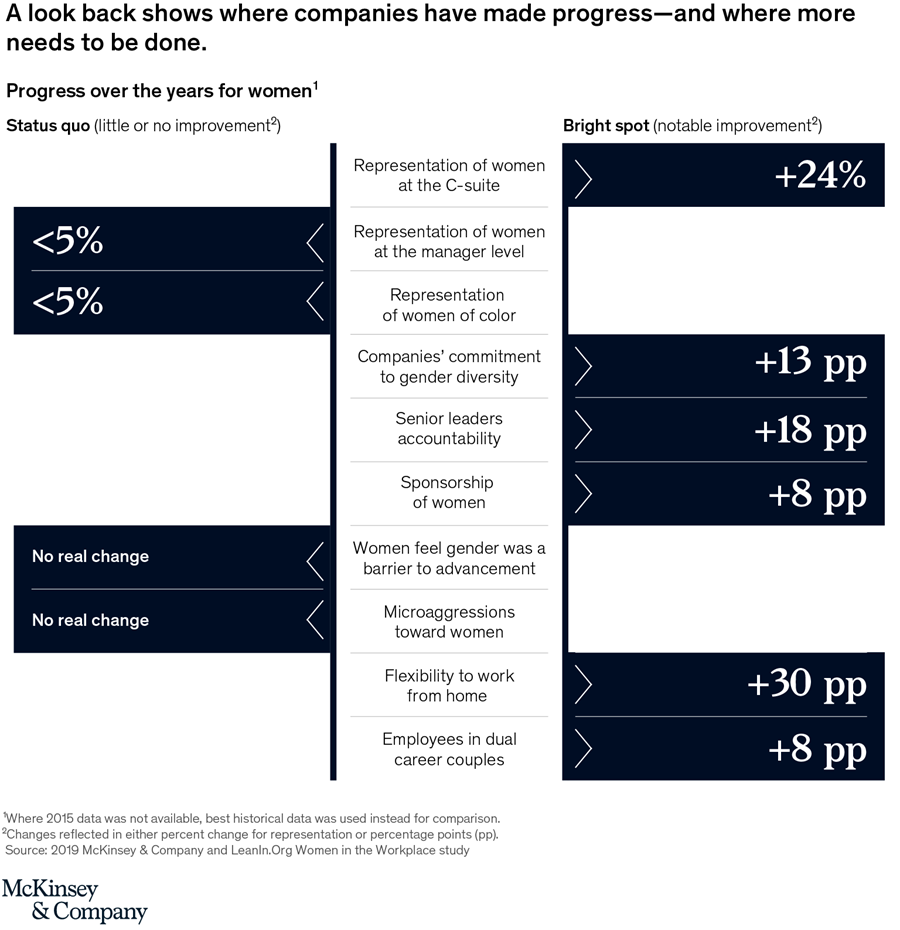This year marks the fifth year of our research on women in the workplace, conducted in partnership with LeanIn.Org. We look back on data and insights since 2015 from close to 600 companies that participated in the study, more than a quarter of a million people that were surveyed on their workplace experiences, and more than 100 in-depth one-on-one interviews that were conducted. (See our infographic below for top-level findings from the past five years.)

We strive to provide individuals with disabilities equal access to our website. If you would like information about this content we will be happy to work with you. Please email us at: McKinsey_Website_Accessibility@mckinsey.com
In the last five years, we’ve seen more women rise to the top levels of companies. An increasing number of companies are seeing the value of having more women in leadership, and they’re proving that they can make progress on gender diversity. This is an important step in the right direction.
Still, women continue to be underrepresented at every level. To change the numbers, companies need to focus where the real problem is. We often talk about the “glass ceiling” that prevents women from reaching senior leadership positions. In reality, the biggest obstacle that women face is much earlier in the pipeline, at the first step up to manager. Fixing this “broken rung” is the key to achieving parity.
The culture of work is equally important. All employees should feel respected and that they have an equal opportunity to grow and advance. Employees care deeply about opportunity and fairness, not only for themselves but for everyone. They want the system to be fair.
Done right, efforts to hire and promote more diverse candidates and create a strong culture reinforce each other. A more diverse workforce will naturally lead to a more inclusive culture. And when a company’s culture feels fair and inclusive, women and underrepresented groups are happier and more likely to thrive.
By fostering diversity, building a culture of opportunity and fairness, and focusing their attention on the broken rung, companies can close their gender gaps—and make progress on the road to equality.
In this article, we share highlights from the full Women in the Workplace 2019 report, diving deep on the parts across pipeline and employee experience that will be most critical for companies to drive change in the next five years.
Despite progress at senior levels, gender parity remains out of reach
Over the past five years, we have seen signs of progress in the representation of women in corporate America. Since 2015, the number of women in senior leadership has grown. This is particularly true in the C-suite, where the representation of women has increased from 17 percent to 21 percent (Exhibit 1).
Although this is a step in the right direction, parity remains out of reach. Women—and particularly women of color—are underrepresented at every level.1 And without fundamental changes early in the pipeline, gains in women’s representation will ultimately stall.
Exhibit 1

We strive to provide individuals with disabilities equal access to our website. If you would like information about this content we will be happy to work with you. Please email us at: McKinsey_Website_Accessibility@mckinsey.com
Companies are adding more women to the C-suite
Today, 44 percent of companies have three or more women in their C-suite, up from 29 percent of companies in 2015 (Exhibit 2). Adding even one woman can make a material difference given the critical role top executives play in shaping the business and culture of their company. Still, the overall representation of women in the C-suite is far from parity. About 1 in 5 C-suite executives is a woman—and only 1 in 25 C-suite executives is a woman of color.
Exhibit 2

We strive to provide individuals with disabilities equal access to our website. If you would like information about this content we will be happy to work with you. Please email us at: McKinsey_Website_Accessibility@mckinsey.com
There are signs the glass ceiling is cracking . . .
More women are becoming senior leaders. This is driven by two trends. First, more women are being hired at the director level and higher than in the past years. Second, senior-level women are being promoted on average at a higher rate than men.
Additionally, men at the SVP and C-levels are slightly more likely to leave their companies, creating more open positions for women to fill.
. . . But a “broken rung” prevents women from reaching the top
Progress at the top is constrained by a “broken rung.” The biggest obstacle women face on the path to senior leadership is at the first step up to manager (Exhibit 3). For every 100 men promoted and hired to manager, only 72 women are promoted and hired. This broken rung results in more women getting stuck at the entry level, and fewer women becoming managers. Not surprisingly, men end up holding 62 percent of manager-level positions, while women hold just 38 percent.
This early inequality has a long-term impact on the talent pipeline. Since men significantly outnumber women at the manager level, there are significantly fewer women to hire or promote to senior managers. The number of women decreases at every subsequent level. So even as hiring and promotion rates improve for women at senior levels, women as a whole can never catch up. There are simply too few women to advance.
The case for fixing the broken rung is powerful. If women are promoted and hired to first-level manager at the same rates as men, we will add one million more women to management in corporate America over the next five years.